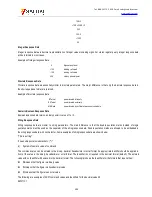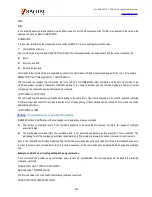
Tel: 886.2.2175 2930 Email: [email protected]
www.salukitec.com
240
8.8.
Linear phase offset
The linear phase offset refers to the phase distortion of the device. The electrical delay function of the analyzer is applied in
measurement to eliminate the linear part of the phase shift and realize high-resolution nonlinear part, i.e. linear phase offset.
8.8.1.
What is linear phase shift?
The signal wavelength will decrease with the incident signal frequency increasing during signal transmission. In this case, the obvious
phase shift will be produced. The phase shift is linear when the phase response of the device is proportional to the frequency. The
trace indicating the relationship between the phase and frequency on the analyzer is an oblique line. The slope is proportional to the
electrical length of the device. The phase shift must be linear for signal transmission without distortion.
8.8.2.
What is linear phase offset?
In the actual cases, the delay time of many devices corresponding to some frequencies is longer than that corresponding to the other
frequencies so as to form the nonlinear phase shift, including distortion of many frequency component signals. One method to
determine the nonlinear phase shift is to measure the linear phase offset.
As phase distortion is caused by linear phase offset, the linear part of the phase response should be removed in measurement. This
can be realized by the electrical delay function of the analyzer. If the electrical length of the tested device is removed mathematically,
the linear phase offset or phase distortion will be left.
8.8.3.
Why to measure the linear phase offset?
Linear phase offset measurement has the following advantages:
a) The measurement result is the phase data, instead of the group delay data in second. The phase data may be more usable for
the device transmitting modulation signals.
b) Provide a measurement method with noise lower than that of group delay measurement.
8.8.4.
Use of Electrical Delay Function
The electrical delay characteristic of the analyzer has the following functions:
1) Simulate the transmission line of adjustable length and no loss to facilitate the installation in or removal from the signal path.
2) Compensate changes of the electrical length of the tested device.
3) Make the phase measurement trace on the analyzer flat, to realize the high-resolution observation of the track and find nonlinear
details of the phase.
4) Provide a method to easily observe the linear phase offset of the tested device.
Fig. 8.20 Observation of Linear phase offset by Electrical Delay Function
See electrical delay details in “6.5.1 Electrical Delay".
8.8.5.
Factors Related to Measurement Accuracy
The frequency response is an error which plays a dominant role in linear phase offset measurement. The through type response
calibration can be applied to significantly reduce the error. In order to achieve higher accuracy, the full 2-port calibration should be






























